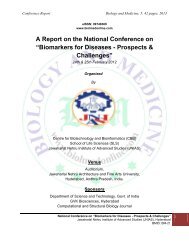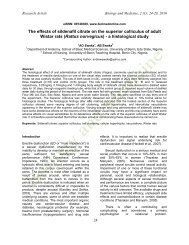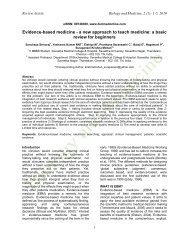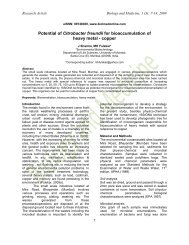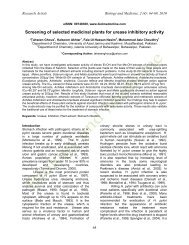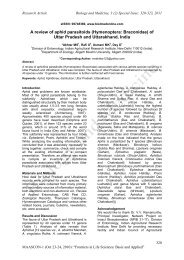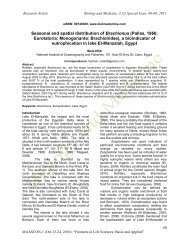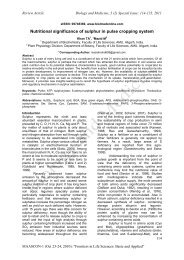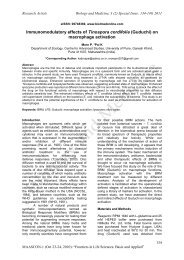You also want an ePaper? Increase the reach of your titles
YUMPU automatically turns print PDFs into web optimized ePapers that Google loves.
Toxeminar-1, Feb 22, 2009 <strong>Biology</strong> <strong>and</strong> <strong>Medicine</strong>, 1 (2): 107-115, 2009<br />
eISSN: 09748369, www.biolmedonline.com<br />
<strong>Chalcones</strong>: Differential effects on glycogen contents of liver, brain<br />
<strong>and</strong> spinal cord in rats<br />
H Jamal* 1,2 , WH Ansari 1 , SJ Rizvi 2<br />
1 Department of Chemistry, Aligarh Muslim University, Aligarh, 202002, U.P., India.<br />
2 Interdisciplinary Brain Research Centre, Aligarh Muslim University, Aligarh, 202002, U.P., India.<br />
*Corresponding Author: jamal_huma555@yahoo.co.in<br />
Abstract<br />
<strong>Chalcones</strong> are precursor compounds for flavonoids biosynthesis in plants, <strong>and</strong> they can also be synthesized in<br />
laboratory. <strong>Chalcones</strong> possess a broad spectrum of biological activities including antioxidative, antibacterial,<br />
anthelmintic, amoebicidal, antiulcer, antiviral, insecticidal, antiprotozoal, anticancer, cytotoxic <strong>and</strong><br />
immunosuppressive. Aldose reductase (AR) enzyme inhibitors have been proposed to prevent or ameliorate long<br />
term diabetic complications. <strong>Chalcones</strong> showed good level of inhibitory activity towards bovine lens aldose reductase<br />
(AR) <strong>and</strong> have been shown the promising compound for the prevention or treatment of diabetic complications.<br />
Although a broad range of biological activities of chalcones have been reported, the mode of action of chalcones on<br />
glycogen is not yet elucidated. <strong>Chalcones</strong> were injected intraperitoneally at the dose of 25mg/kg for seven days. On<br />
the seventh day, one hour after the last dose rats were killed by cervical decapitation <strong>and</strong> their liver, brain <strong>and</strong> spinal<br />
cords were dissected out. Our results showed that out the eight tested chalcones, four chalcones significantly<br />
inhibited (P>0.001) the liver glycogen. There are no significant effects of chalcones on brain <strong>and</strong> spinal cord glycogen<br />
contents. In conclusion, chalcones exert their antidiabetic effect by decreasing only the liver glycogen content. By<br />
comparing the glycogen inhibitory activity structural elements of chalcones responsible for glycogen inhibition could<br />
be identified.<br />
Keywords: <strong>Chalcones</strong>; glycogen content; liver; brain; spinal cord; rat.<br />
Introduction<br />
Glycogen stores in the brain are small relative to<br />
the liver especially muscle. Nevertheless, brain<br />
glycogen turns over rapidly (Pentreath <strong>and</strong> Kai<br />
kai, 1982; Swanson et al., 1989) <strong>and</strong> contributes<br />
significantly to normal brain energy metabolism<br />
(Swanson, 1992; Wender et al., 2000). Brain<br />
glycogen is located entirely in astrocytes<br />
(Koizumi, 1974) which are distributed throughout<br />
the brain but are more concentrated in fiber<br />
bundle <strong>and</strong> white matter (Savchenko et al.,<br />
2000; Sloano et al., 2001). In the mammalian<br />
liver, glycogen is present in the form of rosettes<br />
(Luft, 1956). Glycogen is present in central<br />
nervous system (CNS) although at much lower<br />
concentrations than liver or skeletal muscle with<br />
the commonly accepted ratio of liver/ skeletal<br />
muscle/ brain: 100:1:1 (Nelson et al., 1968). The<br />
concentration of the glycogen in the liver can<br />
vary according to the nutritional state of the<br />
animal. In the liver of fasted rats or mice, this<br />
concentration is about 1-5 mg/g of wet wt <strong>and</strong><br />
increases rapidly at the rate of about 10 mg (g<br />
wet wt) -1 h -1 (Cori, 1926). The accepted role of<br />
glycogen is that of a carbohydrate reserve<br />
utilized when glucose falls below need.<br />
107<br />
However, there is a rapid continuous breakdown<br />
<strong>and</strong> synthesis of glycogen (17μ mol/kg/min)<br />
(Watanabe <strong>and</strong> Passonneau, 1973). The<br />
enzyme systems that synthesize <strong>and</strong> catabolize<br />
glycogen in other tissues are also found in brain,<br />
but their kinetic properties <strong>and</strong> modes of<br />
regulation appear to differ.<br />
Aldose reductase (Alditol: NADP +<br />
oxidoreductase, E.C. 1.1.1.21, ALR2) is the first<br />
enzyme of the polyol pathway, glucose flux<br />
through this pathway, during diabetes, has been<br />
linked to the development of long-term diabetic<br />
complications. Thus, ALR2 inhibitors (ARIs)<br />
have been developed as potential agents to<br />
prevent or delay the onset of diabetic<br />
complications (Raskin <strong>and</strong> Rosenstock, 1987).<br />
There is strong evidence to show that diabetes<br />
is associated with increased oxidative stress<br />
(Mohamed, 1999; Yue, 2003).<br />
Flavonoids with insulin-trigerring <strong>and</strong>/or<br />
insulin like properties have been extracted from<br />
plants (Hii <strong>and</strong> Howell, 1985). <strong>Chalcones</strong><br />
considered as precursors of flavonoids <strong>and</strong><br />
isoflavonids are abundant in edible plants, <strong>and</strong><br />
have been shown to display a diverse array of<br />
pharmacological activities (Dimmock et al.,
Toxeminar-1, Feb 22, 2009 <strong>Biology</strong> <strong>and</strong> <strong>Medicine</strong>, 1 (2): 107-115, 2009<br />
1999). Several hydroxylated <strong>and</strong> methoxylated<br />
chalcones showed good level of inhibitory<br />
activity towards bovine lens aldose reductase<br />
(AR) (Saveri, 1990) <strong>and</strong> have been shown the<br />
promising compound for the prevention or<br />
treatment of diabetic complications (Lim et al.,<br />
2001). In recent report 3-nitro- 2'benzyloxychalcone<br />
showed potent insulin–<br />
stimulated glucose uptake in a concentration<br />
dependent manner in 3T3-L1 adipocytes in a<br />
cell based glucose uptake screening assay<br />
(Rothman et al., 1995).<br />
ALR2 inhibitors have been shown to<br />
prevent or delay significantly diabetic<br />
complications (Raskin <strong>and</strong> Rosenstock, 1987)<br />
<strong>and</strong> chalcones display significant inhibitory<br />
activity towards this enzyme. Thus, the aim of<br />
the present study was to determine the effects of<br />
chalcones on glycogen contents of liver, brain<br />
<strong>and</strong> spinal cord.<br />
Materials <strong>and</strong> Methods<br />
Animals<br />
Adult male albino rats weighing 200-250 gram<br />
were used for the study. The animals were<br />
procured from the central animal house facility at<br />
Jawaharlal Nehru Medical College, Aligarh<br />
Muslim University, Aligarh. The rats were group<br />
housed in polypropylene cages (38×23×10 cm)<br />
under st<strong>and</strong>ard laboratory conditions. They were<br />
allowed free excess of dry rat diet <strong>and</strong> tap water<br />
ad libitum. All procedures described were<br />
reviewed <strong>and</strong> approved by the Institutional<br />
Animal Ethics Committee.<br />
Materials<br />
<strong>Chalcones</strong> used in the study were prepared by<br />
the previously described methods: 2',4',4trihydroxychalcone<br />
(Saveri et al.,1998); 2',4',3,4tetrahydroxychalcone<br />
(Sogawa et al.,1993); 2',2dihydroxychalcone<br />
(Hsieh et al., 1998); 2'hydroxy–3,4-dimethoxychalcone<br />
(Hsieh et al.,<br />
2000); 4',4-dichlorochalcone, <strong>and</strong> 4'–chloro,4methoxychalcone<br />
(Davey <strong>and</strong> Gwilt, 1957); 1,3bis<br />
(4-chlorophenyl) -3- (carboxymethylthio)<br />
propan-1-one, <strong>and</strong> 1-(4-chlorophenyl) –3- ( 4methoxyphenyl)<br />
-3- (carboxymethylthio) propan-<br />
1-one (Levai, 1991). Chemical structures of<br />
chalcones used in this study were given in<br />
Figure 1. The identification of chalcones was<br />
1 13<br />
assessed by H-NMR, C-NMR <strong>and</strong> IR<br />
spectroscopic data.<br />
108<br />
Methods<br />
Rats were divided into nine groups of six<br />
animals each. <strong>Chalcones</strong> were dissolved in<br />
dimethylsulfoxide (DMSO)–normal saline. The<br />
final concentration of DMSO in normal saline did<br />
not exceed 0.5%. The animals in experimental<br />
groups were administered with chalcones<br />
intraperitoneally (i.p.) at the dose of 25mg/ kg<br />
body weight daily for 7 consecutive days. The<br />
animals of control group received a similar<br />
volume of dimethylsulfoxide-normal saline. On<br />
the seventh day, after one hour of the last dose<br />
animals were sacrificed by cervical dislocation.<br />
Their brains, spinal cord, <strong>and</strong> liver were<br />
removed quickly, placed on the petridish over<br />
ice, <strong>and</strong> rinsed with ice-cold physiological saline<br />
solution. The brain, spinal cord <strong>and</strong> liver were<br />
weighed <strong>and</strong> then subjected for the assay of<br />
glycogen estimation.<br />
Glycogen estimation<br />
Glycogen content was estimated colorimetrically<br />
by the method described by Hassid <strong>and</strong><br />
Abraham (1957). The tissue (approx 1gm) was<br />
placed in a pre-weighed centrifuge tube<br />
containing 3 ml of 30% KOH. After the weight of<br />
the tissue had been recorded, the tubes were<br />
placed in a boiling water bath for about 20-30<br />
min. When the tissue was dissolved, the<br />
glycogen was precipitated by the addition of 5 ml<br />
of 95% ethanol. The precipitate obtained was<br />
dissolved in 1 ml of distilled water <strong>and</strong> again<br />
precipitated with 95% ethanol <strong>and</strong> centrifuged at<br />
3000 rpm for 10 min. The glycogen precipitate<br />
was then dissolved in distilled water, <strong>and</strong> this<br />
solution was used to estimate the quantity of<br />
glycogen. To 0.1 ml of aliquot, 5 ml of anthrone<br />
reagent was added <strong>and</strong> mixed by swirling the<br />
tube. The tubes were heated for 10 min in<br />
boiling water, followed by cooling, <strong>and</strong> the<br />
absorbance was recorded at 590 mm. The<br />
readings were compared with that of st<strong>and</strong>ard<br />
glycogen.<br />
Statistical analysis<br />
The data was represented as mean ± SEM. The<br />
statistical analysis of the results was carried out<br />
with a SPSS 11.0 program <strong>and</strong> based on an<br />
analysis of variance (ANOVA) followed by post<br />
hoc test (Tukey). Differences were considered<br />
as significant for p < 0.05 or less.
Toxeminar-1, Feb 22, 2009 <strong>Biology</strong> <strong>and</strong> <strong>Medicine</strong>, 1 (2): 107-115, 2009<br />
Results<br />
Effects of chalcones on the glycogen content<br />
Table 1 depicts the values of glycogen in the<br />
brain, spinal cord <strong>and</strong> liver after intraperitoneal<br />
administration of variably substituted chalcones<br />
at the dose of 25mg/kg body weight for 7 days.<br />
The results showed that chalcones caused no<br />
significant alterations of glycogen content in<br />
brain <strong>and</strong> spinal cord as compared to vehicle<br />
treated group.<br />
ANOVA followed by Tukey post hoc test<br />
showed that intraperitoneal administration of<br />
chalcones at the dose of 25mg/kg body weight<br />
significantly reduced the glycogen content in<br />
liver [F(4, 25) = 15.337, p < 0.001) as compared to<br />
vehicle treated control group.<br />
Discussion<br />
Results of in vitro studies in diabetic <strong>and</strong> in nondiabetic<br />
rats have suggested a<br />
hypoglycemic/insulin-like effect of certain<br />
individual flavonoid-containing seed extracts<br />
(Ahmed et al., 2000; Anila <strong>and</strong> Vijayalakshmi,<br />
2000). Both citrus fruits <strong>and</strong> apples are rich<br />
dietary sources of chalcones <strong>and</strong><br />
dihydrochalcones, <strong>and</strong> these compounds could<br />
even make a greater contribution to the total<br />
daily intake of natural phenolics than the more<br />
extensively studied flavonoids (Tomas-Barberan<br />
<strong>and</strong> Cliford, 2000). It is a largely unresolved<br />
question at present, whether a significantly<br />
enhanced intake as to be expected from dietary<br />
food supplements or certain functional foods, is<br />
consistent with beneficial effects on human<br />
health or whether adverse effects are also to be<br />
taken into account.<br />
In the present study, we used rat liver,<br />
brain <strong>and</strong> spinal cord as an easily accessible<br />
model system to measure the inhibitory potential<br />
of chalcones on glycogen content. Comparing<br />
effects of chalcones on the glycogen content<br />
allowed concluding on structural elements<br />
responsible for effective glycogen inhibition.<br />
Presence of hydroxy <strong>and</strong> methoxy groups<br />
seems to be a m<strong>and</strong>atory element for potential<br />
inhibition of glycogen content, but this inhibition<br />
is observed only in liver <strong>and</strong> not in brain <strong>and</strong><br />
spinal cord. The order of inhibition of glycogen<br />
content in liver is as follows:<br />
ISL > BUT > DHC > HDMC<br />
Compound ISL (isoliquirtigenin; 2',4',4-<br />
trihydroxychalcone) <strong>and</strong> BUT (butein; 2', 4’, 3,<br />
4-tetrahydroxychalcone) with three <strong>and</strong> four<br />
hydroxy groups in positions 2 <strong>and</strong> 4 on both<br />
rings (A <strong>and</strong> B) are found to be more potent<br />
109<br />
inhibitor than compound DHC (2',2dihydroxychalcone)<br />
having only two hydroxy<br />
groups. Presence of two additional methoxy<br />
groups with hydroxy group as in HDMC may<br />
suffice to achieve effective glycogen inhibition.<br />
Presence of chloro groups as in DCC <strong>and</strong> CMC<br />
showed no activity. According to Severi et al the<br />
introduction of thioglycolic group in the chalconic<br />
structure gave an increase in the inhibitory<br />
activity against ALR2 (aldose reductase<br />
enzyme). However, in our study introduction of<br />
thioglycolic group in the chloro substituted<br />
chalcones (CCP <strong>and</strong> CMCP) has no influence<br />
on the glycogen inhibitory activity. Thus,<br />
altogether, these data shows that for an efficient<br />
inhibition of glycogen presence of hydroxy<br />
groups in the ‘A’ ring or methoxy groups in ‘the’<br />
B ring is responsible for inhibition.<br />
Our study indicated that ISL caused a<br />
significant reduction of glycogen content in the<br />
liver (37.17%), without affecting the brain <strong>and</strong><br />
spinal cord glycogen values. Recently it has<br />
been published that isoliquiritigenin found in<br />
licorice roots increases glycogenolysis in rat<br />
hepatocyte perfusion (Abdollahi et al., 2003).<br />
This is consistent with our study that<br />
isoliquiritigenin (ISL) increased the glycogen<br />
depletion in the liver of rats. The liver plays a<br />
major role in blood glucose homeostasis by<br />
maintaining a balance between the uptake <strong>and</strong><br />
storage of glucose as glycogen <strong>and</strong> release of<br />
glucose formed by glycogenolysis <strong>and</strong>/or<br />
gluconeogenesis (Nordlie et al., 1999). There is<br />
also evidence that c-AMP increasing agents<br />
exert a glycogenolytic effect by maintaining<br />
glycogen phosphorylase in a phosphorylated<br />
state (Bollen, 1998). PDE inhibitors can increase<br />
serum glucose levels (Gilfrich <strong>and</strong> Dieterich,<br />
1991) Isoliquiritigenin is a PDE 3 inhibitor with<br />
significant cardiac inotropic <strong>and</strong> vasodialatory<br />
effect which were attributed to an increase in c-<br />
AMP levels (Abdollahi, 2003; Kusano, 1991;<br />
Wegener <strong>and</strong> Nawarth, 1997). Isoliquiritigenin<br />
was found to decrease sorbitol levels in blood<br />
cells, the sciatic nerve <strong>and</strong> the lens of the<br />
diabetic rats <strong>and</strong> thus could have implications in<br />
diabetic neuropathy (Severi et al., 1998). There<br />
is also evidence that the antidiabetic drug<br />
metformin, which acts through inhibition of<br />
hepatic gluconeogenesis, is produces<br />
concurrent antioxidant effects that are most<br />
beneficial in treatment of diabetes (Cosic et al.,<br />
2001). Isoliquiritigenin has been reported to<br />
have the property to scavenge free radicals <strong>and</strong><br />
have the antioxidative capacity (Vaya et al.,<br />
1997; Haraguchi et al., 1998).
Toxeminar-1, Feb 22, 2009 <strong>Biology</strong> <strong>and</strong> <strong>Medicine</strong>, 1 (2): 107-115, 2009<br />
The disturbance of gluconeogenesis<br />
<strong>and</strong> glycogenolysis could have significant<br />
influences on glucose metabolism <strong>and</strong><br />
pathogenesis of diabetes (Atefi et al., 2004;<br />
Abdollahi et al., 2004). Therefore, it could be<br />
concluded that isoliquiritigenin stimulates<br />
glycogenolysis <strong>and</strong> thus depletes hepatic<br />
glycogen storage which in turn needs to be<br />
compensated by blood glucose because hepatic<br />
gluconeogenesis pathway is occluded <strong>and</strong> this<br />
may be a mechanism for antidiabetic effect of<br />
isoliquiritigenin <strong>and</strong> seems to be in relation with<br />
it antioxidant properties. Since the<br />
hyperaggregability of platelets has been<br />
implicated in the pathogenesis of diabetic<br />
complications <strong>and</strong> isoliquiritigenin showed<br />
inhibitory effect on platelet aggregation,<br />
comparable to that of aspirin (Twata et al.,<br />
1992). Thus, the dual or triple effects of<br />
isoliquiritigenin i.e having aldose reductase<br />
inhibition, antioxidant <strong>and</strong> platelet aggregation<br />
inhibition may offer a unique process for<br />
maintaining the glucose by increasing the<br />
glycogenolysis rate.<br />
Compound BUT (butein; 2', 4’, 3, 4tetrahydroxychalcone)<br />
also caused a significant<br />
reduction of glycogen content in the liver<br />
(31.60%), but caused no alterations in the brain<br />
<strong>and</strong> spinal cord glycogen values. It has been<br />
reported that increase of c-AMP formation is<br />
elicited by butein (Sheu-Meei, 1995); c-AMP<br />
also affects storage of glycogen (Larner, 1968)<br />
which is hydrolysed or reduced with the rise in<br />
blood sugar level (Vane, 1962). Butein showed<br />
strong lens AR inhibitory activity. It also showed<br />
strong activity in transition metal chelation <strong>and</strong><br />
free radical scavenging activity <strong>and</strong> the most<br />
promising compound for the treatment of<br />
diabetic complications (Lim, 2001). Recent<br />
human studies have demonstrated that ACE<br />
inhibition improves glucose disposal rate <strong>and</strong><br />
that the effect may be primarily due to increased<br />
muscle glucose uptake (MGU). Butein inhibit<br />
contraction-stimulated glucose transport by<br />
inhibiting the glucose transporter function (David<br />
et al., 2005). In insulin-resistant conditions, ACE<br />
inhibitors can also enhance whole-body glucose<br />
disposal <strong>and</strong> glucose transport activity in<br />
skeletal muscle (Henriksen et al., 1999). Butein<br />
significantly inhibited the ACE activities in a<br />
dose-dependent manner (Chen, 1992). Tumor<br />
necrosis factor-α is implicated in induction of<br />
insulin resistance seen in type-2 diabetes (Ruan<br />
<strong>and</strong> Lodish, 2003). Butein suppressed the<br />
nuclear factor (NF)KB activation <strong>and</strong> also the<br />
expression of COX (P<strong>and</strong>ey, 2007). Butein<br />
110<br />
(BUT) is an effective metal ion chelator <strong>and</strong> a<br />
powerful-chain breaking antioxidant in LDL<br />
systems (Cheng, 1998). In addition, butein<br />
inhibit the platelet aggregation response (Jeon,<br />
2006). Butein also have properties like aldose<br />
reductase inhibition, antioxidant <strong>and</strong> platelet<br />
aggregation inhibition. Thus, it might be<br />
concluded that butein increases the<br />
glycogenolysis rate by depleting the hepatic<br />
glycogen <strong>and</strong> the resulted higher level of<br />
glucose is compensated by increased rate of<br />
glucose uptake by muscles in order to balance<br />
the blood glucose level.<br />
Compounds DHC (2',2dihydroxychalcone)<br />
<strong>and</strong> HDMC (2'-hydroxy-3,4dimethoxy-<br />
chalcone) also caused a significant<br />
reduction of glycogen content in the liver<br />
(23.72% <strong>and</strong> 21.29%), but caused no alterations<br />
in the brain <strong>and</strong> spinal cord glycogen values. α–<br />
Glucosidase plays a physiologically important<br />
role for the digestion process of dietary<br />
carbohydrates to suppress postpar<strong>and</strong>ial<br />
hypoglycaemia (Matsura, 2002). The inhibitors<br />
of α–glucosidase are effective for delaying<br />
glucose absorption, which makes them potent<br />
drugs to control glucose levels in blood (Matsui,<br />
1996). In addition, α–glucosidase inhibitors are<br />
used to ameliorate insulin- resistance (stumvoll<br />
et al., 2005) <strong>and</strong> lower blood glucose<br />
concentration. α–glucosidase inhibitors are<br />
widely used for the treatment of non-insulindependent<br />
diabetes mellitus (NIDDM)<br />
(Hasegawa et al., 1998). Ansari et al., 2005<br />
showed that hydroxy <strong>and</strong> methoxy-substituted<br />
chalcones are potent inhibitors of α-glucosidase.<br />
Also PPARγ agonists improve insulin-resistance<br />
by opposing the effect of TNF-α in adipocytes<br />
(Moller, 2000). Moreover, hydroxy <strong>and</strong> methoxy<br />
chalcones have more potent or similar PPARagonistic<br />
activity compared with troglitazone<br />
(insulin sensitizing CTZP drug) (Jung 2006).<br />
Therefore, it may be concluded that these<br />
chalcones increase the glycogenolysis rate but<br />
delay the absorption of glucose to control the<br />
glucose levels in blood.<br />
Conclusion<br />
<strong>Chalcones</strong>, which are potent inhibitors of aldose<br />
reductase, caused an increase in glycogenolysis<br />
rate by decreasing the liver glycogen content. It<br />
is interesting to note that chalcones showed no<br />
activity against brain <strong>and</strong> spinal cord glycogen<br />
content.
Toxeminar-1, Feb 22, 2009 <strong>Biology</strong> <strong>and</strong> <strong>Medicine</strong>, 1 (2): 107-115, 2009<br />
References<br />
Abdollahi M, Chan TS, Subrahmanyam V, O’Brien PJ,<br />
2003. Effects of phosphodiesterase 3,4,5 inhibitors on<br />
hepatocyte c AMP levels, glycogenolysis,<br />
glucogenesis <strong>and</strong> susceptibility to a mitochondrial<br />
toxin. Molecular <strong>and</strong> Cellular Biochemistry, 252(1-2):<br />
205- 211.<br />
Abdollahi M, Doyavi M, Pournourmohammadi S,<br />
Saadat M, 2004. Hyperglycaemia associated with<br />
increased hepatic glycogen phosphorylase <strong>and</strong><br />
phosphoenolpyruvate carboxykinase in rats following<br />
subchronic exposure to malathion. Comparative<br />
Biochemistry <strong>and</strong> Physiology C, 137(4): 343-347.<br />
Ahmad M, Akhtar SM, Malik T, Gilani AH, 2000.<br />
Hypoglycaemic action of the flavonoid fraction of<br />
Cuminum nigrum seeds. Phytotherapy Research,<br />
14(2): 103-106.<br />
Anila L, Vijayalakshmi NR, 2000. Beneficial effects of<br />
flavonoids from Sesamum indicum, Emblica officinalis<br />
<strong>and</strong> Momordica charantia. Phytotherapy Research,<br />
14(8): 592-595.<br />
Ansari FL, Umbreen S, Hussain L, Makhmoor T,<br />
Nawaz SA, Lodhi MA, Khan SN, Shaheen F,<br />
Chaudhary MI, Rahman AU, 2005. Synthesis <strong>and</strong><br />
biological activities of chalcone <strong>and</strong> 1,5-<br />
benzothiazepine derivatives: promising nea free<br />
radical scavengers <strong>and</strong> esterase , urease, <strong>and</strong> �-<br />
glucosidase inhibitors. Chemistry & Biodiversity, 2(4):<br />
487- 496.<br />
Atefi M, Ghazanfari S, Ostad SN, Ghahremani MH,<br />
Abdollahi M, 2004. Alteration of glucose homeostasis<br />
by rolipram amd milrinone but not sidenafil in rat<br />
primary hepatocytes culture. Progress in Medicinal<br />
Research, 2(13): 1-12.<br />
Bollen M, Keppens S, Stalmans W, 1998. Specific<br />
features of glycogen metabolism in the liver.<br />
Biochemical Journal, 336(Pt 1): 19-31.<br />
Chen CH, Lin JY, 1992. Inhibition of angiotensin 1-<br />
converting enzyme by tetrahydroxixanthones isolated<br />
from Tripterospermum lanceolatum. Journal of<br />
Natural Products, 55(5): 691-695.<br />
Cheng ZJ, Kuo SC, Chan SC, Ko FN, Teng CM,<br />
1998. Antioxidant properties of butein isolated from<br />
Dalbergia odorifera. Biochimica et Biophysica Acta,<br />
1392(2-3): 291-299<br />
Cori CF, 1926. The fate of sugar in the animal body.<br />
The Journal of Bioogical Chemistry, 70(): 577-585.<br />
Cosic V, Antic S, Pesic M, Jovanovic O, Kundalic S,<br />
Djordjevic VB, 2001. Monotherapy with metformin:<br />
111<br />
does it improve hypoxia in type 2 diabetic patients ?.<br />
Clinical Chemistry <strong>and</strong> Laboratory <strong>Medicine</strong>, 39(9):<br />
818-821.<br />
Davey W, Gwilt JR, 1957. <strong>Chalcones</strong> <strong>and</strong> related<br />
compounds. Part I. Preparation of nitro-, amino-,<br />
<strong>and</strong>halogeno- chalcones. Journal of Chemical<br />
Society, 19(3):1008-1019.<br />
David C, Wright, Geiger PC, Han DH, Holloszy JO,<br />
2005. Are tyrosine kinases involved in mediating<br />
contraction- stimulated muscle glucose transport �<br />
American Journal of Physiology, Endocrinology <strong>and</strong><br />
Metabolism, E123- E128.<br />
Dimmock JR, Elias DW, Beazely MA, K<strong>and</strong>epu NM,<br />
1999. Bioactivities of chalcones. Current Medicinal<br />
Chemistry, 6(12): 1125- 1149.<br />
Gilfrich HJ, Dieterich HA, 1991. Tolerance of<br />
enoximone in patients with heart failure. Zeitschrift fur<br />
Kardiologie, 80 (Suppl 4): 93-97.<br />
Haraguchi H, Ishikawa H, Mizutani K, Tamura Y,<br />
Kinoshita T, 1998. Antioxidative <strong>and</strong> superoxide<br />
scavenging activities of retrochalcones in Glycyrrhiza<br />
inflata Bioorganic <strong>and</strong> Medicinal Chemistry, 6 (3):339-<br />
347.<br />
Hasegawa T, Yoneda M, Nakamura K, Ohnishi K,<br />
Harada H, Kyoda T, Yoshida Y, 1998. Long-term<br />
effect of α-glucosidase inhibitor on late dumping<br />
syndrome. Journal of Gastroenterology <strong>and</strong><br />
Hepatology, 13(1212): 1201-1206.<br />
Hasid WJ, Abraham S, 1957. Chemical procedures<br />
for analysis of polysaccharides. In: Methods in<br />
Enzymology, Vol III, Academic Press, New York,<br />
USA, PP: 34-37<br />
Henriksen EJ, Jacob S, Kinnick TR, Youngblood EB,<br />
Schmit MB, Dietze GJ, 1999. ACE inhibition <strong>and</strong><br />
glucose transport in insulinresistant muscle: roles of<br />
bradykinin <strong>and</strong> nitric oxide. American Journal of<br />
Integrated Physiology 277(1): R332-R336.<br />
Hii CS, Howell SL, 1985. Effect of flavonoids on<br />
insulin secretion <strong>and</strong> 45 Ca +2 h<strong>and</strong>ling in rat islets of<br />
Langerhans. Journal of Endocrinology, 107(1): 1-8.<br />
Hsieh HK, Lee TH, Wang JP, Wang JJ <strong>and</strong> Lin CN,<br />
1998. Synthesis <strong>and</strong> anti-inflammatory effect of<br />
chalcones <strong>and</strong> related compounds. Pharmaceutical<br />
Research, 15(1): 39-46.<br />
Hsieh HK, Tsao LT, Wang JP, Lin CN, 2000.<br />
Synthesis <strong>and</strong> Anti-inflammatory Effect of <strong>Chalcones</strong><br />
Journal of Pharmacy <strong>and</strong> Pharmacology, 52(2): 163-<br />
171.
Toxeminar-1, Feb 22, 2009 <strong>Biology</strong> <strong>and</strong> <strong>Medicine</strong>, 1 (2): 107-115, 2009<br />
isoliquiritigenin, an aldose reductase inhibitor in<br />
licorice. European Journal of Pharmacology, 212(1):<br />
87-92.<br />
Jeon WK, Lee JH, Kim HK, Lee YA, Lee SO, Kim YS,<br />
Ryu SH, Kim SY, Lee YJ, Ko BS, 2006. Anti- platelet<br />
effects of bioactive compounds isolated from the bark<br />
of Rhus verniciflua stokes. Journal of<br />
Ethnopharmacology, 106(1): 62-69.<br />
Jung SH, Park SY, Pak YK, Lewe HK, Park KS, Shin<br />
KH, Ohuchi K, Shin HK, Keum SR, Lim SS, 2006.<br />
Synthesis & PPAR- �- lig<strong>and</strong> binding activity of the<br />
new series of 2’- hydroxuchalcone <strong>and</strong><br />
thiazolidinedione derivatives. Chemical <strong>and</strong><br />
Pharmaceutical Bulletin, 54(3): 368-371.<br />
Koizumi J, 1974. Glycogen in central nervous system.<br />
Progress in Histochemistry <strong>and</strong> Cytochemistry, 6(4):<br />
1- 37.<br />
Kusano A, Nikaido T, Kuge T, Ohmoto T, Delle<br />
Monache G, Botta B, Botta M, Saitoh T, 1991.<br />
Inhibition of adenosine 3’,5’-cyclic monophosphate<br />
phosphodiesterase by flavonoids from licorice roots<br />
<strong>and</strong> 4- arylcoumarins. Chemical <strong>and</strong> Pharmaceutical<br />
Bulletin (Tokyo) 39(4): 930- 933.<br />
Larner J, Villar- Palasic, Goldberg ND, Bishop JS,<br />
Huifing F, Wenger JI, Sasako H, Brown NB,1968. In:<br />
Weber G, Eds, Advanc Enzyme Regulation, vol 6, 1 st<br />
Edition, Pergamon Press, pp: 402- 423.<br />
Levai A, 1991. Synthesis of carboxylic acid<br />
derivatives of dihydrochalcones. Monatshefte<br />
Furchemie, 122(1-2): 127-129.<br />
Lim SS, Jung SH, Shin KH, Keum SR, 2001.<br />
Synthesis of flavonoids <strong>and</strong> their effects on aldose<br />
reductase <strong>and</strong> sorbitol accumulation in streptozotocininduced<br />
diabetic rat tissues. Journal of Pharmacy <strong>and</strong><br />
Pharmacology, 53(5): 653-658.<br />
Lim SS, Jung SH, Shin KH, Keum SR, 2001.<br />
Synthesis of flavonoids <strong>and</strong> their effects on aldose<br />
reductase <strong>and</strong> sorbitol accumulation in streptozotocininduced<br />
diabetic rat tissues. Journal Pharmacy <strong>and</strong><br />
Pharmacology, 53(2): 653-658.<br />
Luft JH, 1956. Permanganate, a new fixative for<br />
electron microscopy. The Journal of Biophysical <strong>and</strong><br />
Biochemical Cytology, 2(6): 799-802.<br />
M Tawata, K Aida, T Noguchi, Y Ozaki, S Kume, H<br />
Sasaki, M Chin, T Onaya, 1992. Anti-platelet action<br />
of<br />
Matsui T, Yoshimoto C, Osajima K, Oki T, Osajima<br />
Y,1996. In vitro survey of �- glucosidase inhibitory<br />
112<br />
food components. Bioscience, Biotechnology, <strong>and</strong><br />
Biochemistry, 60(12): 2019-2022.<br />
Matsuur H, Asakawa C, Kurimoto M, Mizutani J,<br />
2002. Alpha-glucosidase inhibitor from the seeds of<br />
balsam pear (Momordica charantia) <strong>and</strong> the fruit<br />
bodies of Grifola frondosa. Bioscience, Biotechnology,<br />
<strong>and</strong> Biochemistry, 66(7): 1576-1578.<br />
Mohamed AK, Bierhaus A, Schiekofer S, Tritschler H,<br />
Ziegler H, Nawroth PP, 1999. The role of oxidative<br />
stress <strong>and</strong> NF (B) activation in late diabetic<br />
complications. Biofactors, 10(2-3): 175-179.<br />
Moller DE, 2000. Potential role of TNF-α in the<br />
pathogenesis of insulin resistance <strong>and</strong> type 2<br />
diabetes. Trends in Endocrinology <strong>and</strong> Metabolism,<br />
11(10): 6212-6217.<br />
Nelson SR, Schulz DW, Passonneau JV, Lowry OH,<br />
1968. Control of glycogen levels in brain. Journal of<br />
Neurochemistry, 15(11): 1271-1279.<br />
Nordlie RC, Foster JD, Lange AJ, 1999. Regulation of<br />
glucose production by the liver. Annual Review of<br />
Nutrition, 19: 379-406.<br />
P<strong>and</strong>ey MK, S<strong>and</strong>ur SK, Sung B, Sethi G,<br />
Kunnumakkara AB, Aggarwal BB, 2007. Butein, a<br />
tetrahydroxychalcone, inhibits nuclear factor (NF) kB<br />
<strong>and</strong> NF- Kb- regulated gene expression through direct<br />
inhibition of IkB� Kinase � on cysteine 179 residue.<br />
Journal of Biological Chemistry, 282(24): 17340-<br />
17350.<br />
Pentreath V, Kai- Kai M, 1982. Significance of the<br />
potassium signal from neurons to glial cells. Nature,<br />
295(5844): 59-61.<br />
Raskin P, Rosenstock J, 1987. Aldose reductase<br />
inhibitors <strong>and</strong> diabetic complications American<br />
Journal of <strong>Medicine</strong>, 83(2): 298-306.<br />
Rothman DL, Magnusson I, Cline G, Gerard D, Kah<br />
CR, Shulman RG, Shulman GI, 1995. Decreased<br />
muscle glucose transport/ phosphorylation is an early<br />
defect in the pathogenesis of non-insulin dependent<br />
diabetes mellitus. Proceedings of the Nationall<br />
Academy of Sciences USA, 92: 983-987.<br />
Ruan H, Lodicsh HF, 2003. Insulin resistance in<br />
adipose tissue: direct <strong>and</strong> indirect effects of tumor<br />
necrosis factor alpha. Cytokine <strong>and</strong> Growth Factor<br />
Reviews, 14(5): 447-455.<br />
Savchenko V, Mckanna JA, Nikionenko IR, Skibo GG,<br />
2000. Microflia <strong>and</strong> astrocytes in the adult rat brain:<br />
comparative immuno-histochemical analysis<br />
demonstrates the efficacy of lipocortin 1<br />
immunoreactivity. Neuroscience, 96(1): 195- 203.
Toxeminar-1, Feb 22, 2009 <strong>Biology</strong> <strong>and</strong> <strong>Medicine</strong>, 1 (2): 107-115, 2009<br />
Saveri F, Benevenuti S, Costantino L, Vampa G,<br />
Melegari M, Antalini L, 1998. Synthesis <strong>and</strong> activity of<br />
a new series of chalcones as aldose reductase<br />
inhibitors. European Journal of Medicinal Chemistry,<br />
33(11): 859-866.<br />
Saveri F, Benveuti S, Costantino L, Vampa G,<br />
Melegari M, Antolini L, 1998. Synthesis <strong>and</strong> activity of<br />
a new series of chalcones as aldose reductase<br />
inhibitors. European Journal of Medicinal Chemistry,<br />
33(11): 859-866.<br />
Severi F, Costantino L, Benvenuti S, Vampa G, Mucci<br />
A, 1996. Synthesis <strong>and</strong> description of chalcone-like<br />
compounds, inhibitors of aldose reductase. Medicinal<br />
Chemistry Research, 6(3): 128-136.<br />
Sheu- Meei Y, Zhi- Jiao C, Sheng- Chu K, 1995.<br />
Endothelium- dependent relaxation of rat aorta by<br />
butein, a novel cyclic AMP- specific<br />
phosphodiesterase inhibitor. European Journal of<br />
Pharmacology, 280(1): 69-77.<br />
Sloane JA, Holl<strong>and</strong>er W, Rosene DL, Moss MB,<br />
Kemper T, A, Abraham CR, 2000. Astrocytic<br />
hypertrophy <strong>and</strong> altered GFAP degradation with age<br />
in subcortical white matter of the rhesus monkey.<br />
Brain Research, 862(1-2): 1-10.<br />
Sogawa S, Nihro N, Ueda H, Miki T, Matsumoto H,<br />
Sathoh T, 1993. 3,4-Dihydroxy chalcones as potent<br />
5- lipoxygenase <strong>and</strong> cyclooxygenase inhibitors.<br />
Journal of Medicinal Chemistry, 36(24): 3904-3909.<br />
Stumvoll M, Goldstein BJ, van Haeften TW, 2005.<br />
Type 2 diabetes: principles of pathogenesis <strong>and</strong><br />
therapy. Lancet, 365(9467): 1333-1346.<br />
Suzen S, Buyukbingol E, 2003. Recent studies of<br />
aldose reductase enzyme inhibition for diabetic<br />
complications. Current Medicinal Chemistry, 10(15):<br />
1329-1352.<br />
Table 1 <strong>and</strong> Figure 1 follow…..<br />
113<br />
Swanson RA, 1992. Physiologic coupling of glial<br />
glycogen metabolism to neuronal activity in brain.<br />
Canadian Journal of Physiology <strong>and</strong> Pharmacology<br />
(Suppl) 70: S138- S144.<br />
Swanson RA, Sagar SM, Sharp FR, 1989. Regional<br />
brain glycogen stores <strong>and</strong> metabolism during<br />
complete global ischaemia. Neurological Research,<br />
11(1): 24- 28.<br />
Tomas-Barberan FA, Clifford MN, 2000. Review.<br />
Flavanones, chalcones, <strong>and</strong> dihydrochalcones-<br />
nature, occurance <strong>and</strong> dietary burden. Journal of the<br />
Science of Food <strong>and</strong> Agriculture, 80(24): 1073- 1083.<br />
Vane JR, 1962. Recent advances in Pharmacology.<br />
3 rd edition, J & A. Churchill Ltd, London, pp: 95- 121.<br />
Vaya J, Belinky PA, Aviram M, 1997. Antioxidants<br />
constituents from licorice roots: isolation, structure<br />
elucidation <strong>and</strong> antioxidative capacity towards LDL<br />
oxidation Free Radical <strong>Biology</strong> <strong>and</strong> <strong>Medicine</strong>, 23(2):<br />
302-313.<br />
Watanabe H, Passonneau JV, 1973. Factors affecting<br />
turnover of cerebral glycogen <strong>and</strong> limit dextrin in vivo.<br />
Journal of Neurochemistry, 20(6): 1543-1554.<br />
Wegener JW, Nawrath H, 1997. Cardiac effects of<br />
isoliquiritigenin. European Journal of Pharmacology,<br />
326(1): 37-44.<br />
Wender R, Brown AM, Fern R, Swanson RA, Farrell<br />
K, Ransom BR, 2000. Astrocytic glycogen influences<br />
axon function <strong>and</strong> survival during glucose deprivation<br />
in central white matter. The Journal of Neuroscience,<br />
20(18): 6804- 6810.<br />
Yue KKM, Chung WS, Leung AWN, Cheng CHK,<br />
2003. Redox changes precede the occurrence of<br />
oxidative stress in eyes <strong>and</strong> aorta, but not in kidney’s<br />
of diabetic rats. Life Sciences, 73(20): 2557-2570.
Toxeminar-1, Feb 22, 2009 <strong>Biology</strong> <strong>and</strong> <strong>Medicine</strong>, 1 (2): 107-115, 2009<br />
Table 1 Effects of chalcones on glycogen content. Data are expressed as means ± SEM.<br />
Glycogen content (mg/g tissue)<br />
Groups Liver Brain Spinal cord<br />
Control (6) 51.3533 ± 2.94 1.8970 ± 0.02 0.7953 ± 0.02<br />
ISL (6) 32.2627 ± 0.88 abc<br />
1.9050 ± 0.08 0.8033 ± 0.02<br />
BUT (6) 35.1220 ± 2.01 abc 1.9133 ± 0.03 0.7833 ± 0.04<br />
DHC (6) 39.1705 ± 0.09 ab 1.9005 ± 0.02 0.7900 ± 0.04<br />
HDMC (6) 41.2540 ± 1.75 a 1.9243 ± 0.06 0.7700 ± 0.04<br />
DCC (6) 48.0687 ± 1.71 1.8482 ± 0.03 0.7637 ± 0.02<br />
DCCP (6) 49.9385 ± 1.72 1.8833 ± 0.05 0.7865 ± 0.06<br />
CMC (6) 49.9778 ± 3.03 1.8035 ± 0.05 0.7575 ± 0.03<br />
CMCP (6) 49.5712 ± 2.97 1.8750 ± 0.03 0.7772 ± 0.05<br />
Figures in parenthesis indicate number of rats. a-c Indicate statistical significance in comparison to vehicle<br />
treated control group at P
Toxeminar-1, Feb 22, 2009 <strong>Biology</strong> <strong>and</strong> <strong>Medicine</strong>, 1 (2): 107-115, 2009<br />
Cl<br />
Figure 1 Chemical structures of the chalcones used in the study<br />
HO<br />
Cl<br />
OH<br />
O<br />
OH<br />
2',4',4- Trihydroxychalcone<br />
Isoliquiritigenin, ISL<br />
OH<br />
HO<br />
HO<br />
115<br />
OH<br />
O OH O<br />
2',2- Dihydroxychalcone<br />
DHC<br />
O<br />
4',4- Dichlorochalcone<br />
DCC<br />
O<br />
4'- Chloro- 4- methoxychalcone,<br />
CMC<br />
Cl<br />
OCH 3<br />
O<br />
OH<br />
OH<br />
2',4',3,4- Tetrahydroxychalcone<br />
Butein, BUT<br />
OCH 3<br />
OCH 3<br />
2'- Hydroxy-3,4- Dimethoxychalcone<br />
HDMC<br />
Cl Cl<br />
O S<br />
COOH<br />
1,3- bis (4- chlorophenyl) - 3- (carboxymethyl<br />
- thio) prop- an- 1- one, DCCP<br />
Cl OCH 3<br />
S<br />
COOH<br />
1- (4- Chlorophenyl)- 3 (4- methoxyphenyl)-<br />
3- (carboxymethylthio) propan-1-<br />
one, CMCP




